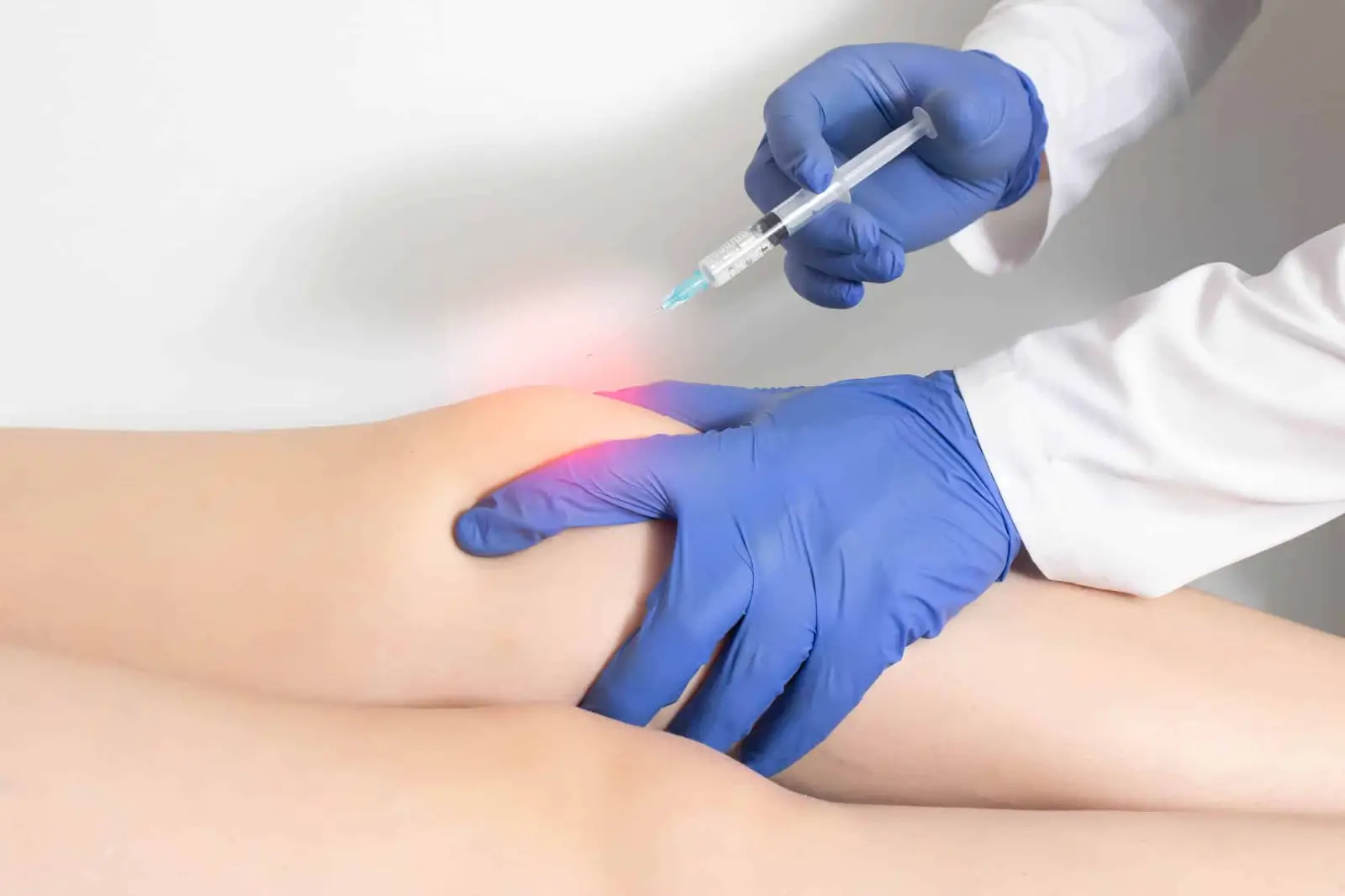
Osteoarthritis is a leading cause of knee pain, affecting millions of people worldwide. Euflexxa, a nonavian hyaluronic acid gel, has become a popular treatment for osteoarthritis knee pain, providing relief by improving joint lubrication and function. While Euflexxa demonstrates significant efficacy in reducing pain and improving mobility, both patients and healthcare providers should know about the potential side effects of the treatment.
Most side effects of Euflexxa are mild and temporary, with common reactions occurring immediately after the injection. These may include arthralgia, back pain, and joint swelling, typically resolving within a few days. However, understanding these side effects helps manage patient expectation and prepare them for the treatment.
In this article, we will provide a complete list of Euflexxa side effects, explain their typical severity and duration, and offer practical advice for monitoring and managing these reactions.
Key Takeaways
- Most side effects from Euflexxa are mild and include pain, swelling, redness, bruising, and stiffness at the injection site. These typically resolve within a few days without the need for medical intervention.
- Headaches, muscle pain, back pain, and general malaise can occur, though they are less common. These symptoms generally improve within a few days.
- Serious reactions like severe joint inflammation, allergic reactions, and pseudo-sepsis are rare but require immediate medical attention.
- Individuals with severe osteoarthritis, a history of joint infections, or autoimmune conditions may be more prone to side effects and require closer monitoring.
- Cold compresses, over-the-counter pain relievers, and rest can help manage mild side effects. Patients should avoid high-impact activities after treatment and follow their aftercare instructions to optimize results.
- Open communication between patients and healthcare providers is essential for promptly addressing any adverse reactions and ensuring optimal treatment outcomes.
About: Doctor Medica is your trusted supplier of top-quality dermal fillers, viscosupplements, and more for your medical practice. We offer genuine products from leading brands at the lowest prices in the market. If you’re looking to order Euflexxa online for your practice, contact Doctor Medica today.
Local Reaction Profile of Euflexxa

Most Euflexxa side effects are localized, meaning they occur near the site of injection. These side effects are typically mild and short-lived, resolving within a few hours to a few days without the need for medical intervention. They are usually the result of either the injection process or the body’s natural short-term response to the hyaluronic acid used in Euflexxa.
Injection-site reactions are not uncommon but are generally not severe.
Common Local Reactions
- Pain at the Injection Site: Patients may feel a mild aching or soreness is commonly felt, especially within the first 24 hours following the injection. This discomfort is generally localized and temporary, often managed with rest or cold compresses.
- Swelling or Joint Effusion: Patients may notice visible swelling or a feeling of fullness in the knee due to temporary fluid accumulation in the joint. This usually resolves within a few days, with no significant harm.
- Warmth or Redness: Mild warmth or redness at the injection site can occur as part of the body’s inflammatory response. These symptoms typically subside as inflammation reduces.
- Bruising: There may also be light bruising near the injection site, particularly if the injection punctures a small blood vessel. It is generally minor, painless, and fades naturally over the course of several days.
- Stiffness: Some patients may experience a feeling of tightness or stiffness in the knee. Light stretching, walking, or range-of-motion exercises can help improve this condition after adequate rest.
These effects are usually manageable with rest, cold compresses, and avoiding strenuous activity for 24 to 48 hours post-treatment. Most patients find that their discomfort improves quickly and does not interfere significantly with daily activities.
Systemic and Musculoskeletal Effects

While rare, some systemic or musculoskeletal symptoms can occur after Euflexxa injections. These reactions, though not typically severe, can be uncomfortable or concerning if they arise unexpectedly.
Reported Systemic or Musculoskeletal Side Effects
- Headache or Fatigue: These are uncommon but may be experienced by some patients following the injection. They are typically mild and often related to the body’s temporary inflammatory response to the hyaluronic acid injection.
- Muscle Pain or Cramping: Discomfort in surrounding muscles, particularly in the thighs or calves, can occur, especially after physical activity or physical therapy. This typically resolves with light stretching or rest.
- Back Pain: A small number of patients report mild lower back pain after the injection. This may be related to changes in posture or movement as the body adjusts to improved knee function.
- General Malaise: Some individuals may describe feeling unwell or mildly fatigued within the first 24 to 48 hours post-injection. This feeling generally resolves without intervention.
These reactions typically improve within a few days and may not require medical treatment unless they persist or worsen. Most individuals find that these symptoms are transient and not a cause for concern.
Allergic and Serious Safety Events
While serious side effects are rare, they should still be taken seriously. Any signs of an allergic reaction or infection following Euflexxa treatment require immediate medical attention. Though Euflexxa is derived from purified bacterial fermentation (not avian sources), allergic responses can still occur in sensitive individuals.
Serious Reactions
- Severe Joint Inflammation or Infection: Symptoms may include high fever, intense swelling, and sharp pain. If any of these occur, it’s essential to contact a healthcare provider immediately.
- Allergic Reaction: This includes rash, itching, swelling of the face or tongue, or difficulty breathing.
- Pseudo-sepsis: A severe inflammatory response that mimics an infection but isn’t caused by bacteria.
- Prolonged or Worsening Joint Pain: This could indicate an underlying issue or improper injection technique. It should be promptly addressed.
In rare cases, if these severe side effects occur, treatment should be discontinued, and medical professionals should be consulted for further evaluation.
Risk Factors and Patient Profile
Certain individuals are more prone to experiencing Euflexxa side effects due to pre-existing conditions or lifestyle factors. Understanding who may be at higher risk helps clinicians provide effective care and manage expectations.
Higher Risk Patients
- Severe Osteoarthritis: Patients with severe osteoarthritis may not respond well to viscosupplementation therapies like Euflexxa. If the cartilage loss is too extensive, hyaluronic acid may not provide sufficient cushioning, potentially increasing the risk of local side effects like stiffness or inflammation.
- History of Joint Infections: Those with a history of joint infections, such as septic arthritis, are at greater risk of complications, as the injection could trigger an inflammatory response or reactivate dormant bacteria.
- Autoimmune Conditions: Conditions like lupus or rheumatoid arthritis may increase the risk of immune responses to injectable therapies. Even though Euflexxa’s generic name, sodium hyaluronate, is highly purified, autoimmune patients may still experience joint swelling, fatigue, or systemic symptoms.
- Strenuous Physical Activity: Patients who resume high-impact exercises too soon after receiving Euflexxa injections may aggravate the treated joint, leading to increased pain or swelling. It’s recommended to avoid such activities for at least 24 to 48 hours after the procedure.
Although rare, allergic reactions to hyaluronic acid-based products do occur. Patients with known sensitivity to sodium hyaluronate or components derived from bacterial fermentation should be screened before the injection to avoid potential adverse effects.
Management Strategies for Adverse Reactions
Managing mild to moderate Euflexxa side effects often involves simple supportive care. Most symptoms resolve without intervention, but early management can prevent escalation and improve patient comfort.
Best Practices for Side Effect Management
- Apply cold compresses to reduce swelling and pain at the injection site.
- Over-the-counter pain relievers, like acetaminophen, can help alleviate any discomfort.
- Rest and activity modification are recommended for the first 24 to 48 hours after the injection.
- Gentle stretching or range-of-motion exercises can help ease stiffness.
- Monitor for signs of infection or allergic reactions, and contact your provider if symptoms worsen.
Clear communication between patients and providers ensures that any unexpected symptoms are addressed promptly.
Conclusion
While Euflexxa side effects are typically mild and temporary, being informed about potential reactions helps patients feel more confident in their treatment. Understanding the full spectrum of side effects ensures better preparation and monitoring throughout the process.
When administered correctly and with consideration of patient-specific risks, Euflexxa remains a safe and effective option for managing knee osteoarthritis. Patients should report any new symptoms and follow post-injection instructions to minimize side effects and maximize the benefits of their treatment.
FAQs
1. How long do Euflexxa side effects last?
Most mild side effects, such as soreness or swelling, typically resolve within 24 to 72 hours. If symptoms persist longer than a week or worsen, consult your healthcare provider.
2. Can I exercise after an Euflexxa injection?
It’s best to rest the knee for at least 24 hours after the injection. Light activity can resume as tolerated, but high-impact or strenuous exercise should be avoided until approved by your doctor.
3. Is an allergic reaction to Euflexxa common?
No, allergic reactions are rare, especially since Euflexxa is non-animal-based. However, if you notice symptoms such as a rash, itching, or difficulty breathing, seek immediate medical attention.
4. How is Euflexxa administered?
Euflexxa is given as a series of three 2 mL intra-articular injections into the knee, each spaced one week apart, by a qualified healthcare professional.
References
Zhang B, Shankara SB, Guo J, Zhang H. Pivotal clinical trials with patient-reported outcome measures in premarket approval applications for high-risk medical devices from 2005 to 2018: Review, examples, and regulatory considerations. Contemporary Clinical Trials. 2022;116:106757. doi:10.1016/j.cct.2022.106757
Euflexxa Side effects, Contraindications. Ndrugs. Published April 22, 2024. https://www.ndrugs.com/?s=euflexxa&t=side%20effects
Peck J, Slovek A, Miro P, et al. A Comprehensive Review of Viscosupplementation in Osteoarthritis of the Knee. Orthop Rev (Pavia). 2021;13(2):25549. Published 2021 Jul 10. doi:10.52965/001c.25549
Ferring B.V. EUFLEXXA Patient FAQ Update. 2019. https://euflexxadev.wpengine.com/wp-content/uploads/2019/12/US-EU-1900050_EUFLEXXA-Patient-FAQ-Update_FINAL.pdf
Related Articles
Joanna Carr
Perfectha vs Juvederm – How Do They Compare?
Compare Perfectha and Juvederm—explore their formulations, benefits, and ideal applications to determine which dermal filler is best for your aestheti...
Joanna Carr
Juvederm for Chin Explained
Interested in learning more about Juvederm for Application On The Chin Area? Browse Doctor Medica's comprehensive archive of blog posts.
Joanna Carr
Juvederm Voluma For Lips Enhancement
Interested in learning more about Juvederm Voluma For Lips Enhancement? Browse Doctor Medica's comprehensive archive of blog posts.


